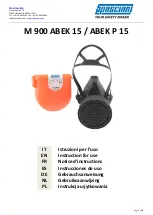
Frequency
Commands
5-27
SR780 Network Signal Analyzer
Frequency Commands (Octave)
OHIB (?) d {, f}
The OHIB command sets (queries) the Highest Band in the Octave measurement
of display d. The parameter f is a frequency (real number of Hz). The Highest
Band is specified to the nearest octave.
For 1 Channel octave analysis, the set command requires d=2.
This command is valid only when the Measurement Group is Octave. The set
command requires display d to be Live.
OLOB (?) d {, f}
The OLOB command sets (queries) the Lowest Band in the Octave measurement
of display d. The parameter f is a frequency (real number of Hz). The Lowest
Band is specified to the nearest octave.
For 1 Channel octave analysis, the set command requires d=2.
This command is valid only when the Measurement Group is Octave. The set
command requires display d to be Live.
ORES (?) d {, i}
The ORES command sets (queries) the Octave Resolution of display d. The
parameter i selects 1/1 (0), 1/3 (1) or 1/12 (2) octave analysis. Changing the
resolution may change the values of the Highest and Lowest Band for display d.
For 1 Channel octave analysis, the set command requires d=2.
This command is valid only when the Measurement Group is Octave. The set
command requires display d to be Live.
OCHN (?) {i}
The OCHN command sets (queries) the Octave Channels. The parameter i selects
1 (0) or 2 (1) channel octave analysis.
This command is valid only when the Measurement Group is Octave. The set
command requires both displays to be Live.
UNST d
The UNST command unsettles the measurement of display d. The measurement
is not actually perturbed by the UNST command. The settling status is set to
unsettled and the full settling time of the measurement is required before the
status returns to settled.
The measurement is unsettled by changing any one of several measurement
parameters. For example, changing the input range or FFT span will unsettle the
measurement. If the signal comes from an external source and is changed in such
a way as to require the measurement to settle, it is convenient to use the UNST
command and wait for settling to finish.
Summary of Contents for SR780
Page 4: ...ii SR780 Network Signal Analyzer ...
Page 10: ...viii SR780 Network Signal Analyzer ...
Page 18: ...1 2 Getting Started SR780 Network Signal Analyzer ...
Page 39: ...Triggering and the Time Record 1 23 SR780 Network Signal Analyzer ...
Page 40: ...1 24 Triggering and the Time Record SR780 Network Signal Analyzer ...
Page 58: ...1 42 Waterfall Display SR780 Network Signal Analyzer ...
Page 70: ...1 54 Saving and Recalling SR780 Network Signal Analyzer ...
Page 167: ...Status Indicators 3 21 SR780 Network Signal Analyzer ...
Page 188: ...4 6 Menus SR780 Network Signal Analyzer ...
Page 193: ...FFT Frequency Menu 4 11 SR780 Network Signal Analyzer Command FEND d f ...
Page 232: ......
Page 236: ...4 54 Source Menu SR780 Network Signal Analyzer Command STYP i ...
Page 266: ...4 84 Playback Input Menu SR780 Network Signal Analyzer ...
Page 272: ...4 90 Trigger Menu SR780 Network Signal Analyzer ...
Page 288: ...4 106 Swept Sine Average Menu SR780 Network Signal Analyzer ...
Page 326: ...144 Exceedance Statistics Menu SR780 Network Signal Analyzer ...
Page 352: ...4 170 Output Menu SR780 Network Signal Analyzer ...
Page 478: ......
















































